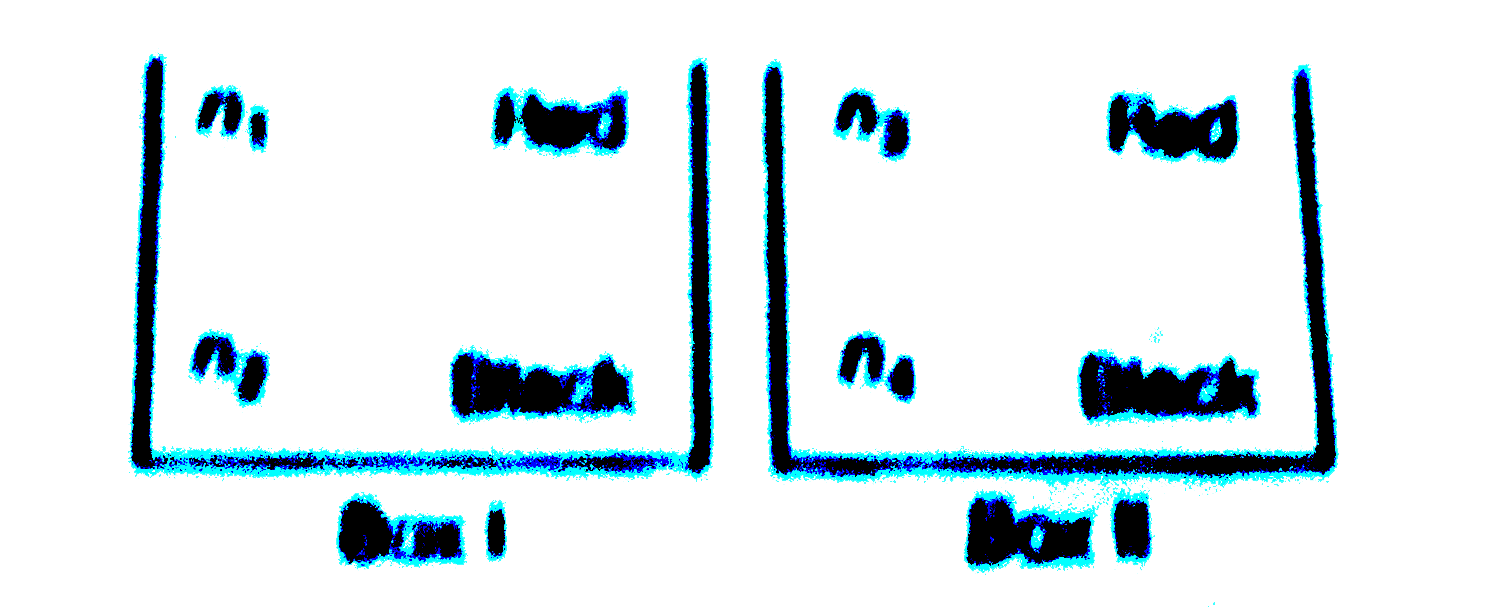Let n1andn2 be the number of red and black balls, respectively, in box I. Let n3andn4 be the numbers of red and black balls, respectively, in the box II.
A ball is drawn at random from box I and transferred to box II. If the probability of drawing a red ball from box I, after this transfer, is 1/3, then the correct options (s) with the possible values of n1andn2 is (are)Solution in Tamil
n1=3,n2=3,n3=5,n4=15
n1=3,n2=6,n3=10,n4=50
n1=8,n2=6,n3=5,n4=20
n1=6,n2=12,n3=5,n4=20
The correct Answer is:B

Let A = Drawing red ball
∴ (A)=P(B1)⋅P(A/B1)+P(B2)⋅P(A/B2)
=12(n1n1+n2)+12(n3n3+n4)
Given, P(B2/A)=13
⇒ P(B2)⋅P(B2∩A)P(A)=13
⇒ 12(n3n3+n4)12(n1n1+n2)+12(n3n3+n4)=13
⇒ n3(n1+n2)n1(n3+n4)+n3(n1+n2)=13
Now, check options,then clearly options (a) and (b) satisfy.
Similar Questions
माना कि बॉक्स I में n1 लाल गेंद और n2 काली गेंद है। माना कि बॉक्स II में n3 लाल गेंद और n4 काली गेंद है।
बॉक्स I और बॉक्स II में से, यदृच्छया (at random) एक बॉक्स को चुना गया और इस चुने हुए बॉक्स से, यादृच्छया एक गेंद निकाली गयी। यह गेंद लाल रंग की पाई गयी। यदि इस लाल गेंद के बॉक्स II से निकाले जाने की प्रायिकता 13 है तब निम्नलिखित में से n1,n2,n3 और n4 के सही संभव मान है (है)
View Solutionमाना कि बॉक्स I में n1 लाल गेंद और n2 काली गेंद है। माना कि बॉक्स II में n3 लाल गेंद और n4 काली गेंद है।
बॉक्स I में से यादृच्छया (at random) एक गेंद निकाली जाती है और उसे बॉक्स II में प्रतिस्थापित (transfer) की जाती है। यदि इस प्रतिस्थापना के बाद, बॉक्स 1 में से एक लाल गेंद निकालने की प्रायिकता 13 है, तब निम्नलिखित में से है, n1 और n2 के सही संभव मान है (है)
View Solutionमाना कि बॉक्स I में n1 लाल गेंद और n2 काली गेंद हैं। माना कि बॉक्स II में n3, लाल गेंद और n4 काली गेंद हैं।
बॉक्स I और बॉक्स II में से, यादृच्चया (at random) एक बॉक्स को चुना गया और इस चुने हुए बॉक्स से, यादृच्चया एक गेंद निकाली गयी। यह गेंद लाल रंग की पाई गयी। यदि इस लाल गेंद के बॉक्स II से निकाले जाने की प्रायिकता 13 है, तब निम्नलिखित में से n1,n2,n3और n4 के सही संभव मान है (है)
View SolutionBox A contains 2 black and 3 red balls while box B contains 3 black and 4 red balls. Out of these two boxes one is selected at random and the probability of choosing box A is double that of box B. If a red ball is drawn from the selected box, then the probability that it has come from box B is
View SolutionLet n_(1)and n_(2) be the number of red and black balls, respectively, in box I. Let n_(3) and n_(4) be the numbers of red and black balls, respectively, in the box II. A ball is drawn at random from box I and transferred to box II. If the probability of drawing a red ball from box I, after this transfer, is 1/3, then the correct options (s) with the possible values of n_(1) and n_(2) is (are)
View SolutionLet n_1, and n_2 , be the number of red and black balls, respectively, in box I. Let n_3 and n_4 ,be the number one red and b of red and black balls, respectively, in box II. One of the two boxes, box I and box II, was selected at random and a ball was drawn randomly out of this box. The ball was found to be red. If the probablity that this red ball was drawn from box II is 1/3 then the correct option(s) with the possible values of n_1, n_2, n_3, and n_4 , is(are)
View SolutionLet n1,andn2, be the number of red and black balls, respectively, in box I. Let n3andn4,be the number one red and b of red and black balls, respectively, in box II. A ball is drawn at random from box 1 and transferred to box II. If the probability of drawing a red ball from box I, after this transfer, is 13 then the correct option(s) with the possible values of n1andn2 , is(are)
View SolutionLet n_(1)and n_(2) be the number of red and black balls, respectively, in box I. Let n_(3) and n_(4) be the numbers of red and black balls, respectively, in the box II. A ball is drawn at random from box I and transferred to box II. If the probability of drawing a red ball from box I, after this transfer, is 1/3, then the possible values of n_(1) and n_(2) is (are)
View Solution
